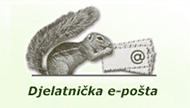TITLE OF COURSE: Research Methodology 4
STATUS OF COURSE/MODULE (REQUIRED/ELECTIVE): Required
NAME OF COURSE/MODULE TEACHER: Aleksandar Lukić; Vuk Tvrtko Opačić; Aleksandar Toskić
LANGUAGE OF INSTRUCTION IN COURSE/MODULE: Croatian, English
NUMBER OF INSTRUCTION HOURS: 12
OUTLINE OF COURSE/MODULE CONTENT
Typology in spatial planning
The purpose of creating typologies. The advantages and shortcoming of typology as a research and planning method. Example of the typology of rural and urbanised settlements in Croatia. Research: aggregate and disaggregative approaches in space typologisation. Variables selection. Multivariate analysis (factor and cluster analysis in creating spatial typology). GIS in creating space typology.
Regionalisation and spatial planning – the example of the tourism and geographical regionalisation of Croatia
Approaches, methods and criteria in tourism and geographical regionalisation on the example of Croatia overall and the individual tourism regions of Croatia. Establishing the homogenous elements as the starting-point for separating the tourism regions. Creating a set of indicators for each homogenous element. Methods of geographical analysis and synthesis: statistical analysis, field polling, spatial modelling, spatial visualisation with creation of thematic maps in GIS. Possible application of research results.
Central settlement system
Theory of central settlements in the light of the Euclid and relational concepts of Geography. An example of drawing up the system of central settlements of Croatia. Methods: qualitative and quantitative approaches in establishing the degree of centrality. The location quotient. Gravitational areas. Statistical methods of analysis of the central settlements system. Application of research results in regional and spatial planning.
Planning and development of rural areas
Contemporary statuary basis of planning (rural) areas in Croatia: spatial planning, regional development, environmental protection, rural development. Identification and evaluation of developmental possibilities and limitations in the rural areas of Croatia, with particular emphasis of the perspectives of the local population. Methods of geographical analysis and synthesis: descriptive statistics, field polling, mapping, spatial visualisation with the creation of thematic maps in GIS.
Tourism and recreation in regional development
Indicators of tourism development in the regional context. Weekend holiday cottages in the coastal area of Croatia as a recreational and tourism activity – indicators of spatial development and the proposal of spatial-planning guidelines for managing secondary weekend recreational housing. The similarities and differences in the spatial development of tourism and weekend cottages in the Croatian coastal area. Methodology of statistical monitoring of tourism and recreation (holiday cottages) – examples from local and foreign sources. Research Methods: statistical analysis, visualisation of spatial data with the aid of thematic cartographic display.
Marginal areas of Croatia – approaches, identification and analysis
The concept of marginality and marginalization. Problems of identification and marginalization measurement. Geographical marginality. Social marginality. Indicators of marginality. Marginalization as a process. Flexibility of the concept: level and perspective. Research methodology: research is possible at all levels from global to local. Identification and geographical analysis of marginal areas is planned with the aid of GIS, polling and interviews along with different statistical methods.
READING LIST
Allmendinger, P., 2009: Planning Theory, Palgrave Macmillan, Basingstoke.
Butula, S., 2003: Planning for Sustainable Development: The Significance of Different Social Interests in Landscape, u: Društvena istraživanja, 65-66, Održivi razvitak Hrvatske, Zagreb, 427-441.
Curić, Z., Glamuzina, N., Opačić, V. T., 2012: Contemporary issues in the regional development of tourism in Croatia, Hrvatski geografski glasnik 74/1, 19-40.
Dery, S., Leimgruber, W. and Zsilincsar, W.: Understanding Marginality: Recent Insights from a Geographical Perspective, Hrvatski geografski glasnik, 74/1, 5-18.
Dühr, S., Colomb, C. Nadin, V., 2010: European Spatial Planning and Territorial Cooperation, Routledge, Oxon.
Emelizanov A.G., 2007: Monitoring Problems of Natural-Antropogenetic Landscapes, Ladscape analysis for sustainable development, Theory and Applications of Lanscape Sciense in Russia, Moscow.
Gebhard K., Mayer M. Roth S., 2007: Sustainable Tourism Management Planing in Biosphere Reserves, A methodology guide, UNESCO, Ecological Tourism in Europe, Germany.
Giaoutzi, M., Nijkamp, P. (ur.), 2006: Tourism and regional development: new pathways, Ashgate, Aldershot.
Lukić, A., 2012: Mozaik izvan grada – tipologija ruralnih i urbaniziranih naselja Hrvatske , Meridijani, Samobor.
Lukić, A., 2012: Typology of rural and urbanized settlements in Croatia and its role in spatial planning, u: Međunarodni znanstveni skup Promišljanje urbanizma: zbornik radova (ur. Karač, Z.), 19. svibnja 2012., Arhitektonski fakultet Sveučilišta u Zagrebu, Zagreb.
Lukić, A., Opačić, V.T. i Zupanc, I., 2009: The Other Side of the Zagreb - Rijeka Motorway : SocioGeographic Implications in the Rural Perphery of Croatia, Društvena istraživanja 18 (1-2), 153-173.
Nejašmić, I.; Toskić, A. (2013): Starenje stanovništva pograničnih područja Republike Hrvatske, predano u tisak (Acta Geographica Croatica, vol. 40, 2013)
Opačić, V. T., 2012: Vikendaštvo u hrvatskom priobalju: jučer, danas, sutra, Hrvatska sveučilišna naklada, Zagreb.
Pejnović, D., 2005: Održivi razvoj naseljenosti na krškom području Hrvatske, Zbornik prvog savjetovanja Hrvatski krš i gospodarski razvoj (ur. B. Biondić i J. Božičević), Centar za krš Gospić/Zagreb, Zagreb, 19-31.
Pejnović, D., Ciganović, A., Valjak, V., 2012: Ekološka poljoprivreda Hrvatske: problemi i mogućnosti razvoja, Hrvatski geografski glasnik, 74 (1), Zagreb, 141-159.
Pelc, S. (2010): Peripherality and marginality of Slovenian border areas Along the Italian border, in: Geographical Marginality as a global issue, vol. 1, IGU
Roca, Z. (ur.),2013: Second home tourism in Europe: lifestyle issues and policy responses, Ashgate, Aldershot.
Šulc, I., Opačić, V. T., 2015: Typology of tourist resorts in Croatia: the case of South Dalmatia, Mitteilungen der Österreichischen Geographischen Gesellschaft, 157, 229-252.
Toskić, A.; Njegač, D.; Orešić, D.: Žumberak: A marginal region in Zagreb's peri-urban fringe // PECSRL 2014, 26th session of the Permanent European Conference for the Study of the Rural Landscape, Unraveling the Logics of Landscape / PECSRL 2014 Gothenburg : University of Gothenburg, 2014.
Toskić, A., Ilić, M. (1997.): Neka prostorna i hijerarhijska obilježja urbanog sistema Hrvatske, HGG 59, Zagreb.
Vukonić, B. Keča, K., 2001: Turizam i razvoj: pojam, načela, postupci, Mikrorad, Zagreb.
DESCRIPTION OF INSTRUCTION METHODS
Lectures and consultations. Each course teacher shall deliver 2-4 lectures, depending on the representation of the theme and methodology.
DESCRIPTION OF COURSE/MODULE REQUIREMENTS
Regular attendance at lectures. Giving form to the methodological framework of his/her own research. Fulfilment of obligations shall be confirmed by the course teachers by their signatures in the student’s record book (Index).
DESCRIPTION OF MONITORING OF TEACHING QUALITY
The mechanisms of institutional monitoring of teaching quality (the Regulations on Doctoral Study of the University of Zagreb, Form DR.SC. -04, DR.SC. -09).
ECTS: The ECTS system shall not be applied.
TITLE OF COURSE: Research Methodology 5
STATUS OF COURSE/MODULE (REQUIRED/ELECTIVE): Required
NAME OF COURSE/MODULE TEACHER: Martina Jakovčić; Jelena Lončar; Dražen Njegač; Zoran Stiperski
LANGUAGE OF INSTRUCTION IN COURSE/MODULE: Croatian, English
NUMBER OF INSTRUCTION HOURS: 12
OUTLINE OF COURSE/MODULE CONTENT
Changes in the city’s functional structure
Analysing the influence of contemporary macro-processes such as de-industrialisation, post-Fordism, globalisation and internationalisation on the functional structure of the city and the consequences on a micro-level. The influences of changes in the city’s functional structure on the socio-space structure. Analysis of the current state of changes in the city’s functional structure as a result of the re-design/conversion of individual spaces. Estimation of the sustainability of planned and executed conversions of city land and identification of the socio-spatial influence of such individual conversions on the local community and on the functional structure of the broader space. Application of diverse methods and tools: mapping, analysis of existing maps, plans and aerial photos, autopsy method, various socio-economic analyses, SWOT analysis of selected locations. Analysis of diverse frameworks and indicators of sustainable urban development. Study of cases encompasses selection and analysis of potential city locations that have undergone functional conversion over the last 20 years.
Changes in the commercial (shopping) structure of the city
Analysing changes in the commercial structure in the transitional period. Analysing changes in the spatial structure of the city on the example of the city of Zagreb. Analysing the consequences of the development of shopping centres (malls) on the changes in the commercial structure of the city. Analysis of the participants in selecting the location for building shopping centres. Analysis of the changed function of shopping centres. Research Methodology: processing of statistical data, mapping, interviews and the polling method.
Economic and social changes in the Croatian area
Research shall encompass economic and social changes of various spatial scope, from small settlements, towns, and to regions and entire countries. The time frame shall be the present. Research shall be based on official statistical data, questionnaire data, structured interviews, and other available sources. Economic changes relate primarily to the level of development, development factors, attitude to the environment, the influence of war, mutual comparison, shaping the region. GIS technology is applied in the spatial analysis of data. Research Methodology: analysis of accessible statistical data, structured interviews, polling.
Changes in the spatial structure of Croatian cities and the urban regions of Croatian cities
Spatial organisation and the development of the Croatian regions. Research Methodology: field research, mapping and polling, processing and analysis of statistical data, analysis of cartographic images.
Sustainable regional and economic-geographic development
Sustainable development at local and regional level (settlements, cities, municipalities, counties). Analysis of change in regional anf economic-geographic structure at above mentioned levels. Comparison and analysis of factors and idexes in regional and economic-geographic development. Assesment of future regional development trends. Comparison of regional indicators. Research methodology: statisitc analysis, mapping, field research, surveying, interviewing and other forms of individual data gathering.
READING LIST
Braičić, Z., Lončar, J. (2015): Economical-geographical Analysis of Differentiated Development in Croatian Coastal Region, Revija za geografijo, 10-1, 7-24, Unverza v Mariboru, Filozofska fakulteta, Oddelek za geografijo
Braičić, Z., Stiperski, Z., Njegač, D., 2009: Utjecaj gospodarske tranzicije i rata na promjene u prostornoj slici zaposlenosti Sisačke regije, Hrvatski geografski glasnik 71 (1), 103-125 Jakovčić, M., Spevec, D., 2004: Trgovački centri u Zagrebu, Hrvatski geografski glasnik 66 (1), 47-65
Lukić, A., Jakovčić, M., 2004: Location and function of hypermarkets and shopping centers in Zagreb, Dela 22, 39-54
Jakovčić, M., 2006: Business functions and the problem of closure of commercial outlets in Ilica street in Zagreb, Hrvatski geografski glasnik 68 (1), 27-50
Jakovčić, M., Rebernik, D., 2008: Comparative Analysis of Development of Retail and Shopping Centres after 1990. in Ljubljana and Zagreb, Hrvatski geografski glasnik, 70 (2), 33-48
Jakovčić, M., Rendulić, I., 2008: Razvoj i funkcije kupovnih centara u Zadru, Geoadria 13 (1),97-117
Lončar, J., Marinković, V.: Development and regional economic problems and perspectives: Case study Slavonia and Baranja (Croatia), Zbornik Matice srpske za društvene nauke, 148, 629-642.
Lončar, J., Marinković, V. (2015): Analysis Of Socio-Economic Indicators In The Context Of Regional Development Of Eastern Croatia, Hungarian Geographical Bulletin, Budapest, Hungary, 64(4), 325-342.
Lončar, J., Maradin, M. (2009): Environmental challenges for sustainable development in the Croatian North Adriatic littoral region, Dela, 31, 159-173, Ljubljana
Njegač, D., 1991: Neki pokazatelji polariziranog razvoja Hrvatskog zagorja, Radovi GO 26, 79-98
Njegač, D., Toskić, A., 1999: Rural diversification and socio-economic transformation in Croatia, GeoJournal 46, 263-269, Dordrecht
Njegač, D., Gašparović, S., Stipešević, Z., 2010: Promjene u funkcionalno-prostornoj strukturi Osijeka nakon 1991. godine, Hrvatski geografski glasnik 72 (2), 101-121
Njegač, D., Gašparović, S., Stipešević, Z., 2012: Promjene u morfološkoj strukturi Osijeka nakon 1991. godine, Acta Geographica Croatica 38, 59-73
Stiperski, Z., 1995: Hijerarhija činitelja industrijske lokacije na primjeru zapadne Hrvatske. Prostor, Vol. 3., Br. 1(9). Zagreb. 11-24
Stiperski, Z., Kamenov, Ž., 1996: Razlozi doseljavanja u Zagreb. Prilog anketnom istraživanju urbanizacijskih činitelja. Prostor, 4 (2), Zagreb, 147-156
Stiperski, Z., Pavlakovich, V. K., 2001: Odnosi i veze u prigraničnim područjima na primjeru hrvatsko-slovenske granice. Dela 16 – Socialnogeografska problematika obmejnih območij ob slovensko-hrvaški meji. Ljubljana, 119-134
Stiperski, Z., Lončar, J., 2008: Changes in Levels of Economic Development among the States Formed in the Area of Former Yugoslavia. Hrvatski geografski glasnik. 70 (2), Zagreb, 5-32
Stiperski, Z., Lorber, L., Heršak E., Ptaček P., Gorka Z., Kološ A., Lončar J., Faričić J., Miličević M. , Vujaković A., Hruška A., 2011: Identity through Urban Nomenclature: Eight Central European Cities. Geografisk Tidsskrift-Danish Journal of Geography 111(2), 181-194
DESCRIPTION OF INSTRUCTION METHODS
Lectures and consultations. Each course teacher shall deliver 2-4 lectures, depending on the representation of the theme and methodology.
DESCRIPTION OF COURSE/MODULE REQUIREMENTS
Regular attendance at lectures. Giving form to the methodological framework of his/her own research. Fulfilment of obligations shall be confirmed by the course teachers by their signatures in the student’s record book (Index).
DESCRIPTION OF MONITORING OF TEACHING QUALITY
The mechanisms of institutional monitoring of teaching quality (the Regulations on Doctoral Study of the University of Zagreb, Form DR.SC. -04, DR.SC. -09).
ECTS: The ECTS system shall not be applied.




